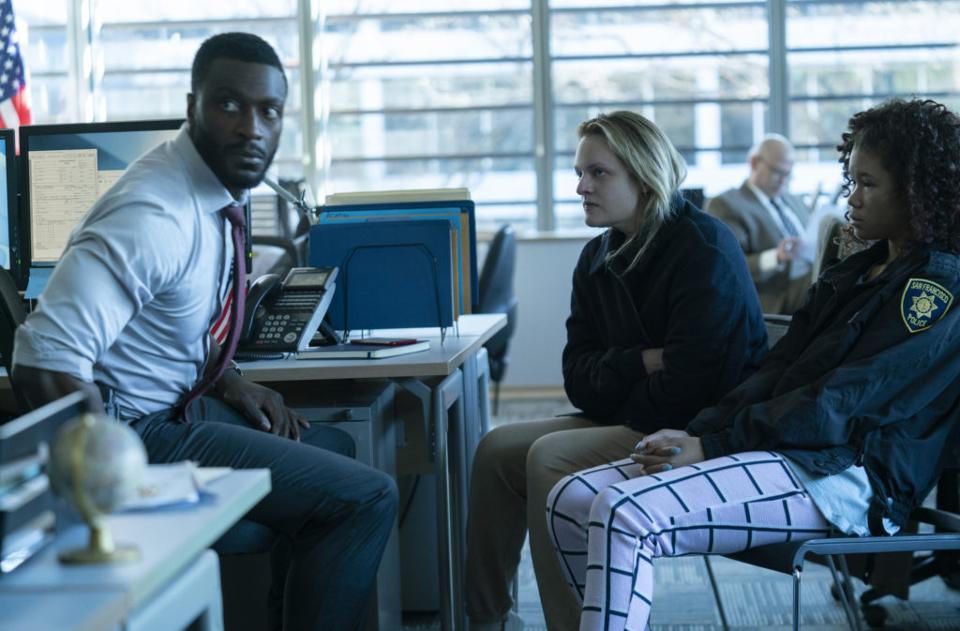
There’s virtually no dialogue in the first five minutes of The Invisible Man, but that doesn’t stop the director Leigh Whannell from telling you everything you need to know. We open in the dead of night, on a woman lying awake in bed, her partner’s arm slung across her waist like a fleshy chain. Her eyes wide with anxiety, she silently extricates herself from his grasp, then tiptoes through their opulent beachside home, packing a bag and disabling the alarm. She also deactivates the house’s many security cameras, except for one: the feed from the bedroom, which she routes to her phone and keeps glancing at in panic, worried that her jailer might have risen. As she quietly maneuvers toward the exit and her freedom, the tension mounts, with various obstacles—a dog’s dish, a car’s sensor, a looming enclosure—conspiring to impede her escape.
It’s the first of many gripping sequences in the movie, an expertly orchestrated medley of image, sound, and music. Yet beyond highlighting Whannell’s considerable craft, the opening is meaningful for the way it telegraphs the film’s metaphorical intentions. The Invisible Man is, quite simply, a picture about domestic abuse. It examines how powerful men feel entitled to possess beautiful women, resulting in violence that’s both physical and emotional. And it contemplates how such subjugation corrodes victims’ health and self-worth, how it can be toxic and dehumanizing. Also, there’s an invisible man.
Or is there? For more than an hour, the movie unfolds as a spooky mystery, forcing you to pay acute attention to its environs and maybe question its protagonist’s sanity. After our runaway, Cecilia (a terrific Elisabeth Moss), flees her gorgeous cell in that aforementioned prison by the sea, her domineering boyfriend, Adrian (Oliver Jackson-Cohen, from The Haunting of Hill House), commits suicide. This initially puts Cecilia at ease, even if Adrian’s brother, Tom (Patriot’s Michael Dorman), shoots her dark looks while informing her that she’s inherited Adrian’s substantial fortune. But her newfound sense of security is short-lived. Over time, during her stay with her friend James (City on a Hill’s Aldis Hodge) and his teenage daughter, Sydney (Storm Reid, from A Wrinkle in Time), strange things start to happen. A knife disappears. A burner on the stove overheats. She misplaces her materials for work. A doctor finds drugs in her system that she doesn’t remember taking. And Cecilia becomes convinced not only that Adrian is still alive, but that he’s learned how to become invisible and is using his patented cloaking technology to torment her.

Is she right? Or is she an unreliable narrator whose mind has frayed such that she’s creating her own demented reality? Perhaps I only ask the question because I’ve seen too many twisty thrillers, but it’s difficult to watch The Invisible Man without guarding yourself against some sort of flagrant rug-pull. Whannell’s script admirably recognizes how women are regularly disbelieved or casually dismissed when reporting abuse, but he also invites our speculation, encouraging us to partake in a tedious guessing game.
Still, whether Cecilia is being gaslighted or is genuinely unhinged, her predicament remains consistently unnerving. The cinematic conceit of The Invisible Man—in which a deadly threat could be lingering anywhere in the frame, unseen by character and viewer alike—is both tantalizing and weirdly challenging; it requires investing banal locations, like hallways and kitchens, with an elemental dread. Yet Whannell, who cut his teeth with James Wan on the Saw and Insidious franchises, exhibits a natural talent for wringing suspense out of seemingly basic setups. His camera, operated by Stefan Duscio, hovers on vacant spaces, prodding your imagination to wonder if Adrian is right in front of you, poised to strike. When Cecilia climbs a ladder to the attic, you squirm in anticipation of her impending descent, while the simple shot of a phantom puff of breath will give you the shivers.

As Cecilia’s misadventures grow increasingly traumatic, The Invisible Man paradoxically becomes less intense; as is typically the case in horror cinema, the relentless buildup is more disturbing than the inevitable payoff. (For another recent example of this phenomenon, see The Lodge, which tucked Riley Keough into a chilly and chilling cabin before slowly leaking steam.) But what the film sacrifices in fear and ambiguity, it makes up for with jolts of surprise and visual ingenuity. Much like in his prior feature, Upgrade, Whannell appreciates the value of low-key practical effects, and it’s downright fun watching Cecilia wield a variety of ordinary tools—a can of paint, a fountain pen, a fire extinguisher—as weapons in her battle against her camouflaged foe.
Indeed, the second half of The Invisible Man is a veritable set piece machine. A lengthy sequence in an asylum, which finds guns floating in midair, hums with energy and inventiveness, while a scene where Cecilia is inexplicably buffeted to and fro plays like Edward Norton’s duel against himself in Fight Club, only with the absurdity replaced by outright terror. The movie’s most bravura moment takes place in the ostensibly safe confines of a swanky restaurant; I won’t spoil anything, but I’ll never trust silverware again.

Even more so than most horror concepts, The Invisible Man demands significant suspension of disbelief. Its dubiousness lies not so much in the premise that Adrian, an expert in “optics” (much like the antihero in H.G. Wells’ novel), might have actually created a stealth suit, but in his ability to avoid detection; to be invisible is not to be incorporeal. (He also belongs in the pantheon of nemeses who are impossibly intelligent, yet whose passwords are pathetically easy to guess.) But it seems churlish to interrogate the film so literally, especially when its concerns are allegorical as well as visceral. If anything, the flawlessness of Adrian’s campaign of manipulation against Cecilia—the way he surreptitiously bends objects and people to his will—only makes her pain more resonant. He’s haunting her from beyond the grave, yet everyone around her still assumes that she’s the problem.
It’s easy to pity Cecilia, but it would be foolish to underestimate her, which is where Moss’ brilliant performance comes in. She’s given precious little to play off of, but she still captures the character’s frenzied panic, eyes locking onto mundane items with utter dismay. Yet she also taps into Cecilia’s resourcefulness, a hidden resolve that makes her a legitimate adversary rather than a helpless victim. It’s oddly thrilling, watching Moss process information and slowly turn fear into strength. The movie’s villain may be invisible, but its greatest attraction is very much in plain sight.
Grade: B
Jeremy Beck is the editor-in-chief of MovieManifesto. He watches more movies and television than he probably should.
